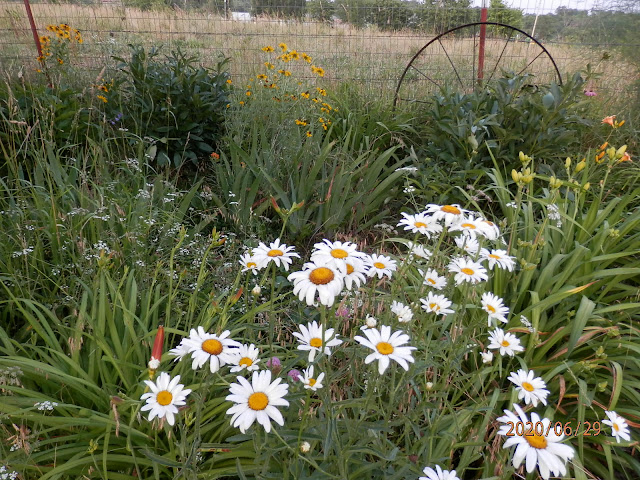There was some standing water there in the springtime deluges. I guessed that all life was extinct. The Perma Bed at that point was being covered with three bags of topsoil Lissa brought me, then more mulch.
However, I wanted so desperately to have green beans that I loosened the sad soil on the right with a turning fork. I didn't turn it over, just poked the tines in the hard dirt, every few miserable inches. That necessitated hopping on the fork and wiggling it, then struggling to get the fork back out.
Next, I ran Tillie, which bucked like a bronco. As a last resort, I attacked the big clods with a small mattock . I felt not unlike a member of a chain gang sentenced to hard labor.
After more rains, the soil returned to the same rock-like consistency, only with big chunks of dirt as an unwelcome extra.
In desperation, and giving up for the season entirely, I decided to feed the dirt for next year. My idea was to send an invitation to all microbes and earthworms to come to a feast.
First, I made a tub of chicken manure tea. Even with sugar, it was unpalatable. I sloshed it over the bed by the bucketful. Then I made a tub of fish fertilizer tea from a bottle that had been around for years. Ditto with slinging it over the lumpy soil.
Last of all, I covered the whole bed with mower-bagged grass, weeds and clover, both red and white. Thereupon I collapsed into a lawn chair and vowed to take up another hobby.
Two weeks later, I peeked under the mulch and discovered moist FRIABLE soil. Acting quickly, before the dream vanished, I used a dibble and planted green bean seeds every few inches, not disturbing the soil or mulch any more than absolutely necessary.
As I did so, I recalled that was exactly the method that Ruth Stout had advocated, about fifty years ago, just pulling the mulch back and planting without tilling. Of course when I read her books, I was not an elderly woman myself and strongly believed in the Troy Bilt ads showing Joy and Torture.
My big red tiller has been down in one of the outbuildings for years. It worked fine when I had someone to disc our 90 x 90 loamy garden and spread barn bedding with a huge manure spreader in the fall. Now I have a hillside tier of short beds that the tiller is too big for.
Ruth's book, How to Have a Green Thumb Without An Aching Back is long out of print but is certainly worth finding. It really works!
Mulching has always been part of my gardening, but it was as a cover to stop weeds and conserve moisture. The thing I don't like about the Perma Bed is it's not any good for starting seeds, with the bottom layer being rotting cardboard. I must have my dirt.
The Perma Bed has been great for the tomato and pepper plants, now bearing bountiful crops. Some cantaloupe Lis started early are looking promising, too.
As a reward for getting right on the bean planting, a big thunderstorm rolled in during the night.
Now the beans have sprouted, along with a patty pan squash. From now on, I vow to treat my soil like dirt and give it more dead fish emulsion and chicken poop tea. I'll cover it with a blanket of mulch to keep the hot summer sun from baking it. I swear to remember a lesson I should have learned fifty years ago: more mulch!











